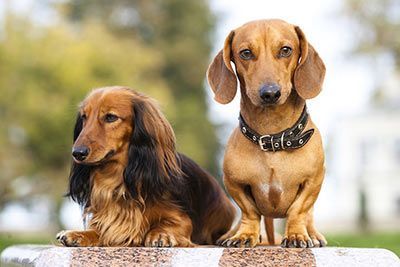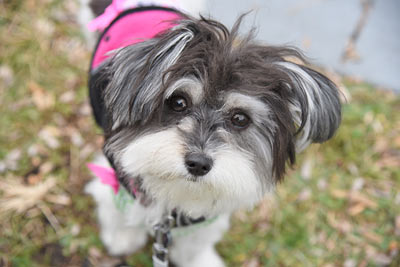Dachshund
Dachshund Dog Breed Information
| Size | 6.7-11 inches (17-27 cm) |
| Weight | 11-20 lbs (5-9 kg) |
| Origin | Germany |
| Color | Brown, gold, red, black, red |
| Lifespan | 12-15 years |
| Suitable As | Family dog, companion dog |
| Personality | Adventurous, curious, enjoys sniffing and digging |
| Exercise | |
| Drooling | |
| Shedding | |
| Grooming |

Breed Characteristics
The Dachshund is a very playful and comical dog. In Germany they have a nickname for it: Teppichporsche. "Teppich" means carpet and Porsche is the famous sports car. You can hardly resist its charm, when you look at a Dachshund proudly heading your way with their long bodies on those short legs. The dachshund is loyal to his family and friendly to children (but only to the one's in its "pack"). It gets on well with other pets, too - especially when it grows up with them as a puppy. It enjoys cuddling with its owner on the sofa.
Dachshunds are fearless, independent, wild, a little impatient and can be quite stubborn. But it is also a good watchdog. It is suspicious of anyone who does not belong to its family. no matter if it is an adult or a child. This is why it has a tendency to bark loudly, too. If a Dachshund feels that its "pack" is threatened, it will be ready to protect it straight away.

Discipline and Training
It’s not hard to teach a Dachshund commands. But it takes discipline and persistence. Often training fails due to us, as we simply give in too much and too easily. Because we make too many exceptions. Because our little pooches are sooo cute and we just melt when looking into those puppy dog eyes. But this helps neither the human nor the dog. At the end of the day, everyone is happier when there are clear, easy-to-understand rules.
Exercise
Because of their small size and body, many believe that a dachshund doesn't need much exercise. But that's not true. They don't want to walk for a long time and as far as a Border Collie, Husky or Dalmatian, but they do love to move!
Top Activities
Hide and Seek, Chase, Agility

Pros and Cons
Pros
- Will be fine in an apartment
- Good guard dog
- Not a lot of grooming
- Doesn’t shed a lot
Cons
- Not a "beginner” dog
- Needs more exercise than you might expect
- A little stubborn
- Gets overweight easily
- Tends to bark a lot
- Strong prey drive

Health and Care
Due to their long bodies Dachshunds often have problems with their backs. If the dog gets enough exercise and gets proper nutrition (to keep a healthy weight), this is less likely to happen - but no guarantee. Dachshunds should not jump up or down from high places, e. g. from the sofa. That could hurt its spine. Dachshunds do shed, but compared to other breeds they are in the midfield. Longhairs and Wirehairs should be brushed on a regular basis (more often than a Shorthair).
Appearance
Dachshunds have a very long body and very short legs. There are shorthaired, longhaired and wirehaired dachshunds and they come in all kinds of colors - e. g. red, cream, black and tan, black and cream, chocolate, blue and tan and so on. There are two sizes: standard and miniature (which is smaller). In Germany they come in three sizes: standard, miniature and "kaninchen". The latter is German and means "rabbit".
History and Origin
The Dachshund was originally used as a hunting dog especially for hunting badgers. Even today, they enjoy enthusiastically sniffing around.
Where Does the Name Come From?
Dachshund is made of "Dachs", which is German and means badger, and "Hund" which is also German and means dog. In former times these dogs helped hunting badgers inside their burrow's narrow tunnels. In Germany they are called Dackel or Teckel (hunter's jargon). Dachshund is pronounced "dakshunt". Was the hot dog named after the dachshund? That seems like a perfect match at the first glance. Dachshunds somehow look like sausages, sorry! But there is no proof of this, so it's just a myth!
Cruel Breeding
The dachshund breed is considered an animal cruelty. It has a body that is way too long and legs that are way too short. Therefore, it often has deformed bones, malpositions and herniated discs. This can even lead to lameness. It is called "dachshund paralysis". The dogs need medication, physiotherapy and, if in doubt, even an operation. However, there is no guarantee of improvement. There is no cure for this disease and the beloved pets can be in pain for the rest of their lives.
If you don't want to support this breed, you shouldn't buy a puppy. That doesn't mean you can't have a dachshund at all. A great number of them are waiting in animal shelters for a loving home. If you don't let your dachshund climb stairs or jump up and down the sofa, you can still give your dog a good life. Or you just choose one of the other breeds. There are so many great ones!
Fun Facts
The first Olympic mascot was a dachshund. It was introduced at the 1972 Olympic Games in Munich (Germany) and the Dachshund's name was Waldi.
The Spanish painter Pablo Picasso had a dachshund.
Comparable Breeds



































